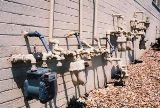The final dumping ground for much of our waste is the ocean. The ocean will stop much of the urban and industrial discharges. Not only does it receives the wastewater, but in many cases, used to throw garbage or even radioactive waste.
80% of the substances that pollute the ocean originate from land. Land-based sources of diffuse pollution are the most important. Includes small pockets as septic tanks, cars, trucks, etc. and larger ones such as farms, farmland, forests, etc... Maritime accidents are responsible for about 5% of oil spills at sea. Instead, a city of five million a year just pouring the same amount that spilled from the Exxon Valdez accident in Alaska.
Approximately one third of the pollution reaching the sea begins as air pollution but then eventually falls into the oceans.
In the deep ocean, at this time, is tens of thousands of barrels of substances such as plutonium, cesium and mercury, the result of decades of use of the ocean as a dumping ground for large amounts of waste. For example, as a result of injuries suffered by several warships from 1956 until 1989, eight nuclear reactors complete with all its fuel, and 50 nuclear weapons, at the bottom of several seas on the planet.
Excess nutrients cause eutrophication also in large sea areas. At the mouth of the Mississippi, for example, has lost much of its wildlife as a result of nutrient enrichment continued by the excessive growth of algae and oxygen depletion caused by the putrefaction of algae.
About 60% of marine species live in the age of 60 km closer to the coast. They are particularly affected by pollution in the seas and oceans, particularly in the vicinity of the coast.
The purifying capacity of the masses of sea water is very large. They dilute, disperse or degrade large amounts of sewage, oil, industrial waste and even radioactive materials. For this reason it has systematically resorted to using the sea as a dump.
Coastal areas are those that have suffered most from human activity. A large part of the world's population lives near coasts. For example, in Europe, about 30% of the population lives within 50 km. the coast. This means that much of the shores of the world's oceans have serious pollution problems.
The discharges are the main source of coastal pollution. In most developing countries and in many parts of the developed cities spills are usually made directly into the sea untreated sludge.
In addition, areas where water renewal is slower (marshes, estuaries, bays, harbors) are the most battered. They are often found fish with tumors and severe illness, or shellfish fishing and consumption which are banned because they contain high doses of toxic chemicals.


0 comments:
Post a Comment